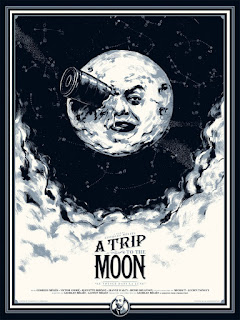Since the invention of the movie
camera in the late 1800's filmmaking has been evolving at a steady pace. In the
beginning, directors tended to use one continuous shot as opposed to several
edited together and it wasn't until 1927 when 'The Jazz Singer' was released
did synchronised dialogue really make its mark in the filmmaking world.
One of the most popular silent movies
was 'A Trip to the Moon (1902).
Directed by and starring Georges Méliès it
follows a group of astronomers who travel to the moon, led by Méliès who plays
the role of Professor Barbenfouillis.
A Trip to the Moon (1902)
Containing minimal editing, and using a series of single shots, A Trip to the Moon is regarded as the earliest example of the science fiction genre and is an influence on the music video 'Tonight, Tonight by the band Smashing Pumpkins, who use the plot of A Trip to the Moon but with faster, more modern editing.
In the Smashing pumpkins video, the costumes, makeup and overall art direction pays homage to that in A Trip to the Moon. Instead of the iconic scene of the rocket-ship crashing into the moon's eye, the 2 astronomers parachute down onto the moon using their umbrellas.
Synchronous sound
Before sound could be captured simultaneously to picture, there was the golden age of silent films. This era was famous for over the top (slapstick) acting, the use of inter-titles (titles between shots), and live-music accompaniment to films in theatres. Even early projectionists are credited to have done live sound effects for films too (surely one of the most fun jobs in the last century). But it all meant there were narrative limitations.
The process of synching sound had been achieved in 1914 with The Photo-Drama of Creation, in which slides and phonograph records were synched up. But it was Warner Brothers’ “Vitaphone” that took the system to feature films. Recording sound effects (including dialogue) and adding musical scores all started with the major motion picture The Jazz Singer (1927) which is regarded as the first film to have synchronised dialogue – and singing for that matter. Screenwriting and acting slowly took on a whole new meaning, and new genres were formed, as dialogue became a key component of films marking the beginning of ‘the talkies’.
Colour
Colour changed film for the better.
Not only because it gave the medium the ability to mimic life more
realistically than ever before, but it also led to more narrative
possibilities, with the prime example being The Wizard of Oz (1939) which
famously depicted Dorothy’s Kansas in black and white, but then brought Oz to
magical life in Technicolor.
Early digital compositing started in the 1940s with the ‘traveling matte’ – a process that was used to superimpose backdrops with actors performing against a blank, coloured wall. These screens’ colours have changed throughout the decades, but the process and effect have remained the same. It is a time-consuming technique in which a scene is filmed against the coloured (green) screen, then re-filmed with a filter on the lens that removes all the coloured (green) areas of the film. Lastly, the layers are composited together in a final recording by laying them over each other one frame at a time. You can’t help but respect the technique. It allowed for actors to be ‘anywhere in the world’ and also create optical illusions, all the while saving on production costs.
The fantasy
film The Thief of Bagdad (1940) is thought to be the first to use a blue-screen
effect with its rather entertaining ‘genie’.
Portable Equipment /
Camera Rigs
The dolly and steadicam are inventions that signify benchmark camera techniques. Simply put, The dolly, is the placing of the camera on wheels that move along tracks. The subsequent smooth movement means that you can follow people walking and talking or get sweeping opening shots, especially when you combine it with a crane.
One particularly difficult, yet visual striking, effect on film is the ‘zolly shot’, where the cameraman zooms while moving a camera on a dolly to get shots like the one below.
The steadicam was the solution to many a cameraman’s problem – getting the smoothness of a dolly system, but with the freedom of hand-held shooting.
Analog to digital
editing
Long before the advent of digital editing and likes of Final Cut Pro, Adobe Premiere & Sony Vegas and other software becoming the the mainstay in movie editing, editing was done by hand, using a strip of film and a specialised cutting device, known as a splicer.
Film was literally cut and glued/taped back together giving an entirely more literal meaning to the term cut and paste.
It’s hard to believe that there were once films with absolutely no CGI, but you have to go back 40 years to 1973, and the sci-fi Westworld, to find the first use of computer-generated imagery in film. Aptly it was a 2-D digital rendition of a robotic-cowboy’s vision… we wouldn’t want it any other way.
Its sequel Futureworld (1976) and
Tron (1982), then introduced 3-D to the masses, and the rest is history.
Science fiction and fantasy filmmakers rejoiced because they finally had the
tools to visually depict the world and themes their characters explored.
Pixar created the first
feature-length computer-animated movie in Toy Story (1995) and nowadays it’s
more and more uncommon for films not to make use of CGI in one way or another,
as it often saves on production costs.
A prime example where CGI would have
been a cheaper option is in the infamous Kevin Costner would-be blockbuster,
Waterworld (1995), where everything was built on a giant set rather than
created in CGI… it only went over budget by US $75-million, a huge sum back in
the day.


No comments:
Post a Comment